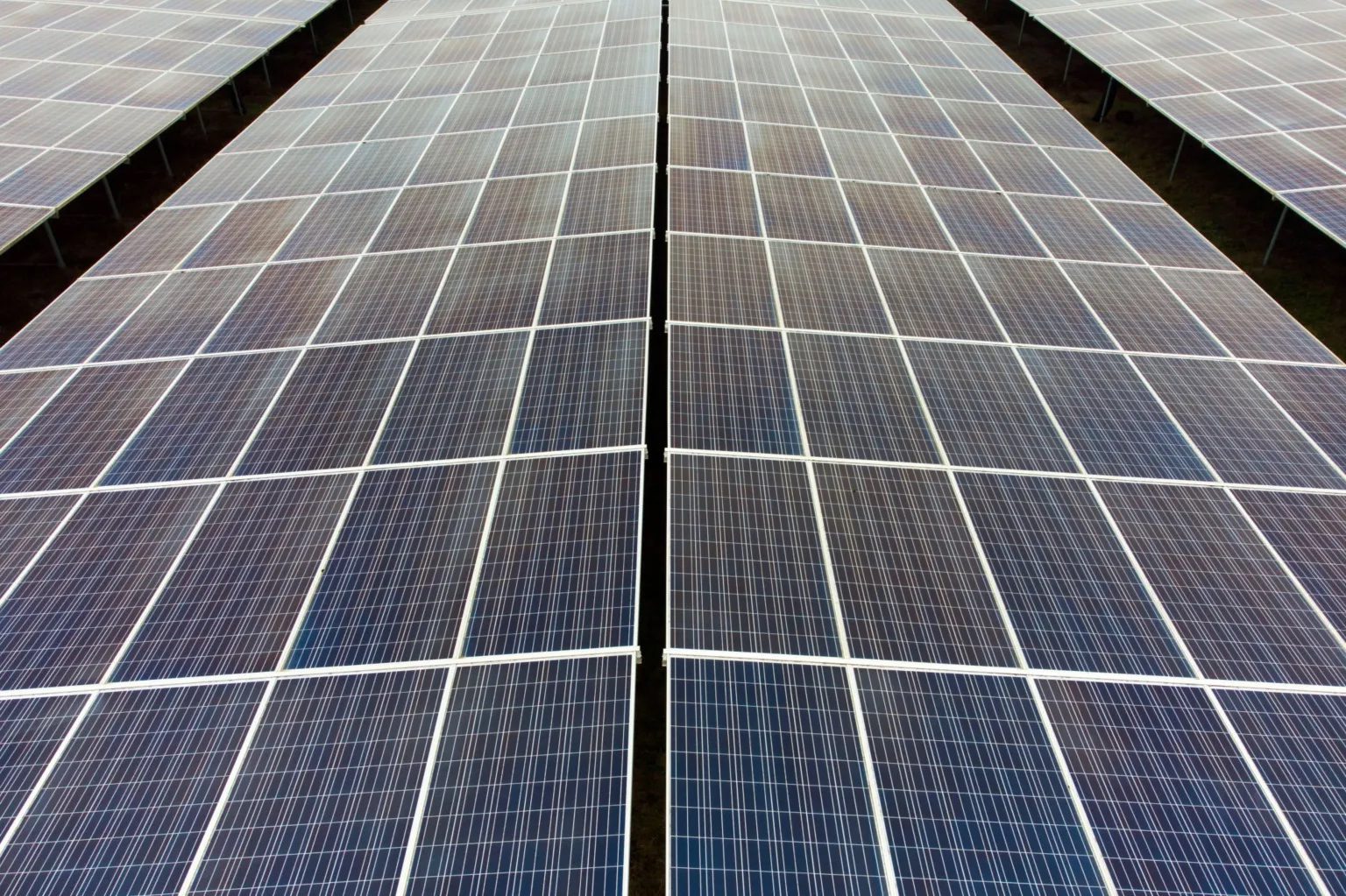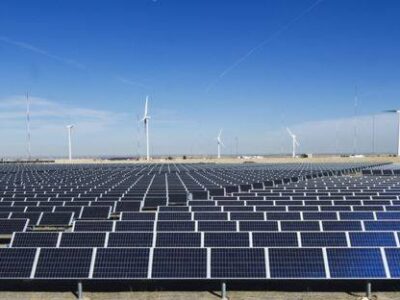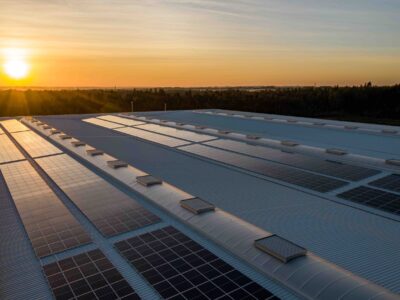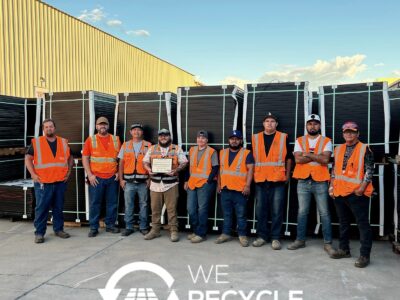(Bloomberg) —
The greening of red-state America, well underway in the Sun Belt, is now accelerating in the Midwest. Ohio and Indiana — two Republican-led US states long dependent on coal power — are on the verge of solar-farm booms so staggering that their respective buildouts between now and 2027 may vie with Nevada’s and trail only those of California and Texas.
Developers are expected to install 15 gigawatts’ worth of new photovoltaic panels in the two states, enough to power about 12 million households. That’s happening even as Ohio has moved to slow, if not thwart, renewable energy projects.
No Republican members of Congress — a group that includes the majority of members from Indiana and Ohio — voted to pass the Inflation Reduction Act, President Joe Biden’s climate law that ushered in hundreds of billions of dollars in incentives for clean energy.
Red states stand to reap the gains regardless: “When you look at renewable energy, the reddest Republican areas are the ones that are benefiting the most,” said Nick Cohen, chief executive of Doral Renewables, which is building what will be one of the largest US solar projects, a $1.6 billion complex in the Hoosier State.
The low cost of solar power, and the promise of construction and manufacturing jobs, are indeed winning over communities in the Midwest that may not be predisposed to the climate benefits. It helps that Ohio and Indiana feature flat farmland that’s ideal for tracking the arc of the sun. Another impetus is coming from large electricity customers, including tech giants and manufacturers, which are demanding that clean energy help power their data centers and factories.
While Indiana doesn’t require that any of its power come from renewable sources, the state is finding that it can cultivate the sun as it does soybeans. “You’re seeing a state like Indiana really punch way above its weight class” in solar farms, Governor Eric Holcomb, a Republican, told Bloomberg Green’s podcast Zero in January. “We’re a small state, relatively speaking, but we have a lot of land, which is required.”
Ohio and Indiana have some of the lowest grid-connection costs in the electric grid that stretches from Washington, DC to Chicago, according to clean energy research group BloombergNEF. Across both states there are 23 development-stage projects that would each generate more than 300 megawatts of power, BNEF’s data shows. A 300-megawatt farm is about half the capacity of a typical natural gas-fired power plant, but sizable by the standards of US solar.
Today, utility-scale solar in Ohio costs less than half the price tag of an efficient natural gas-fired plant, including tax credits for renewables, said Amar Vasdev, an analyst at BNEF. In Indiana, solar is more than a third cheaper.
But barriers persist in Ohio. Despite utility companies such as AES Corp. and American Electric Power Co. pushing to modernize their networks with clean power and major employers exerting pressure, the state in the past decade has imposed various impediments to renewable energy development.
“Ohio is doing a good job of attracting large-scale employers and manufacturing, but those investments are going to need in-state renewables, which is becoming harder to permit,” said Cyrus Tashakkori, president of Open Road Renewables, a company developing large projects in the state.
Ohio’s Republican leadership has tried to prop up coal and nuclear plants that have struggled to compete with solar, wind and natural gas. In 2019, the state passed a controversial law to bail out nuclear plants and scale back a minimum renewable requirement. The bill wound up at the crux of what federal prosecutors say is the largest corruption case in state history. It included utility giant FirstEnergy Corp. admitting that it conspired with public officials and others to pay millions of dollars in bribes toward the law’s passage. The legislator at the center of the case, ex-Ohio House Speaker Larry Householder, is on trial in federal court in Cincinnati.
Perhaps most concerning for the solar industry: a rule that empowers local communities to reject solar plants and designate areas where projects aren’t permitted.
Roy Klopfenstein, a newly elected state representative in Ohio representing Paulding County, said he supported some renewables projects when he was a local official. But Klopfenstein, a Republican, said he still worries that the solar boom coupled with the closure of coal plants leaves the state vulnerable to power shortages at sunset and on cloudy days. “It should be about what the constituents want,” he said of the siting of solar farms. “Each community is different. I am a supporter first of property rights.”
Trying to avoid local rejections can make development more arduous. Some developers are facing complaints from residents about how solar panels would change the look and use of the landscape. Jane Harf, executive director of Green Energy Ohio, a nonprofit that promotes sustainable energy, said solar has to clear a bar in Ohio that other land uses don’t have to meet. Whereas neighbors could stop a farmer from adding solar panels, “if he suddenly wanted a hog farm, they couldn’t stop him — and a hog farm is a lot more offensive to neighbors.”
Late last year, a major solar project in Ohio that would have been built on farmland was terminated following strong pushback from area residents. It was a big loss for the landowners, who would have benefited from lease payments.
For farmers, solar is a way to “balance the financials” after years of corporate consolidation in the industry, said Rachel Tayse, executive director of the Ohio Ecological Food and Farm Association. There is concern, however, that big solar developers can outbid farmers for land by paying prices too steep to turn a profit on any type of crop, Tayse said. “Our communities need both — they need renewable energy and they need food.”
The pace of Ohio’s solar boom suggests that developers aren’t being scared off. The best way to prevent rejection “is to get into the communities early so they’re supportive,” said Michael Arndt, the president and general manager of Recurrent Energy, a developer owned by panel manufacturer Canadian Solar Inc. “We try to find early champions.”
Expected tax revenues from solar projects have won over some communities. Miller City, a village of 160 people in Putnam County in northwestern Ohio, hopes a 150-megawatt solar project being developed by Avangrid Inc. will provide sufficient tax revenues to install a $3.6 million sewer collection system the village has sought for two decades. “We are not going to start anything until they start putting in solar panels,” said James Erford, Miller City’s longtime mayor.
The Miller City project has been in the works for about five years. First, the Covid-19 pandemic and supply snarls slowed development. Now, there’s a possibility of further surveys being required. “It definitely could be delayed,” Erford said. “I don’t think it would be canceled.” He’s hopeful that groundbreaking will happen in July.
Some farmers in Indiana, meanwhile, are receptive to the prospect of new revenues from solar fields on their land, said Doral’s Cohen: “We’ve been in their barns drinking their homebrews and target-shooting in the back.”
(Details on grid-connection costs added in seventh paragraph.)
To contact the authors of this story:
Brian Eckhouse in Los Angeles at beckhouse@bloomberg.net
Naureen S Malik in New York at nmalik28@bloomberg.net
© 2023 Bloomberg L.P.





